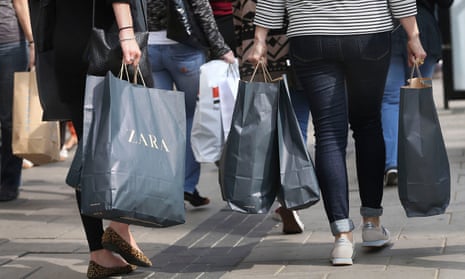Britain’s consumers continued spending after the summer sales, despite the steepest annual growth in non-food store prices in almost three decades.
Growth in retail sales volumes rose by 1% in August after the Office for National Statistics revised the figure for July up to 0.6%, beating analysts’ expectations for an increase of 0.2%. The pound leapt against the dollar on the figures, which add weight to a potential rate hike by the Bank of England for the first time in a decade.
Spending in clothing stores continued, the ONS said, despite price increases after the end of the busy summer period, likely to be as a result of sales promotions ending. Footwear stores also fared well in the back-to-school shopping season.
Kate Davies, a senior statistician at the ONS, said: “We are seeing strong price increases across all store types compared with a year ago, reflecting wider inflationary pressures. However, we are still seeing underlying growth in sales volumes, and with strong growth in non-essential purchases as consumers continued to buy more from non-food stores.”
British households are coming under sustained pressure from rising prices, putting a squeeze on living standards. The consumer price index measure of inflation rose to 2.9% in August, from 2.6% in July. Wages are failing to keep pace, with a cut of 0.4% for real average earnings.
Prices have soared as the pound dropped to its lowest levels since the mid-1980s in the aftermath of the Brexit vote last year, pushing up the cost of imports. The jump is particularly sharp in some areas, such as petrol, textiles, clothing and footwear.
Non-food stores and online shops recorded their highest year-on-year price growth since March 1992, at 3.2% and 3.3% respectively. Still, consumers are continuing to spend, with these sectors driving the growth in retail sales in August, both in terms of value and volume.
While wages are failing to keep pace with inflation, more people are in work than at any time since the mid 1970s. But there are fears households are using debt to keep on spending amid the squeeze.
Stephen Boyle, chief economist at Royal Bank of Scotland, said: “While rising employment means more people are earning and can spend, that can’t account for the growth in retail sales. Either we dipped into our savings or we borrowed more last month.”
The quantity bought within food stores remained flat on the month, whereas petrol stations showed increases in both the amount spent and quantity bought, at 0.2% and 0.1% respectively.
Shoppers are increasingly heading online. Average weekly spending via the internet in August was £1.1bn, an increase of 15.6% compared with the same month a year ago. Excluding automotive fuel, the amount bought by value accounted for 16.4% of all retail spending, up from 15% a year ago.
However, economic and political conditions ahead for shoppers are far from ideal, which some economists expect will lead to a slowdown in spending. “We still expect growth in retail sales volumes to disappoint over the coming months,” said Samuel Tombs, the chief UK economist at the Pantheon Macroeconomics consultancy.

Comments (…)
Sign in or create your Guardian account to join the discussion